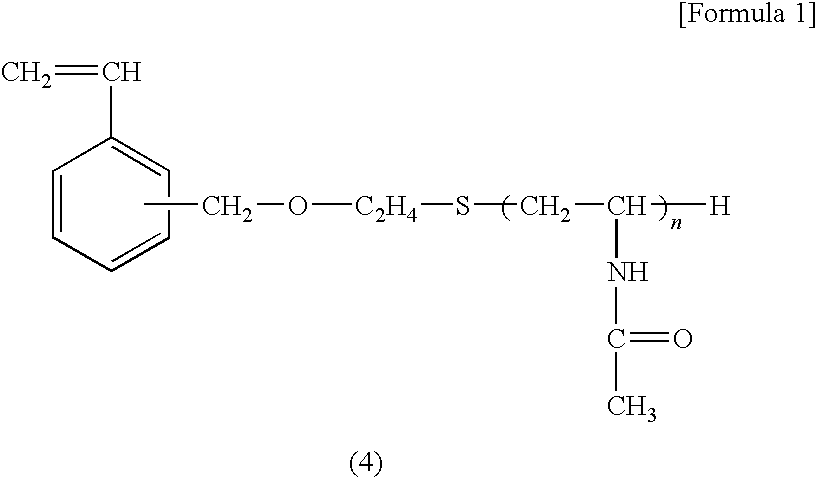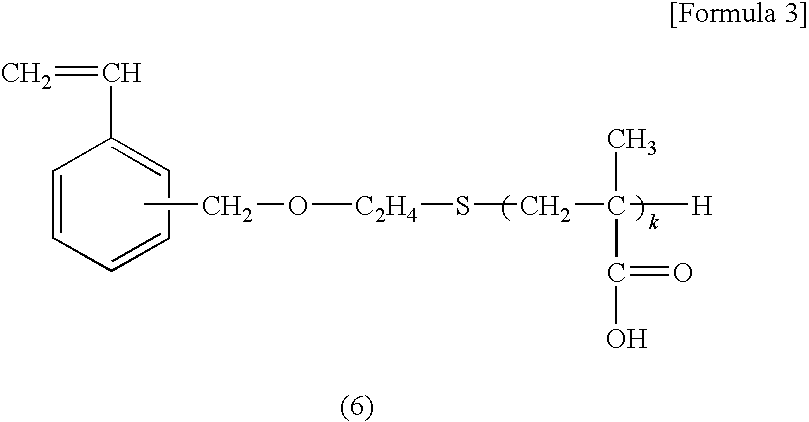Diagnostic Marker
- Summary
- Abstract
- Description
- Claims
- Application Information
AI Technical Summary
Benefits of technology
Problems solved by technology
Method used
Image
Examples
example 1
[0072]In a mixed solution of 5 mL of ion-exchanged water and 10 mL of ethanol, 1.0 g of the macro-monomer A obtained as described above, 1.0 g of styrene, and 15 mg of N,N-azobisisobutylonitrile were dissolved; after 30 minutes of nitrogen gas bubbling, the resulting solution was sealed and shaken in a 60° C. water bath for 24 hours to form fine particles.
[0073]The fine particles were centrifugally separated and freeze-dried to obtain objective fine particles. The fine particles had an average diameter of 400 nm (as measured with the dynamic light scattering method).
[0074]To 100 mg of the fine particles thus obtained, 5 mg of the fluoresceinated cholesterol obtained as described above were added. After the resulting mixture was dispersed in 5 mL of ethanol, 10 times in volume of ion-exchanged water were further added with stirring. Then, the fine particles were centrifugally separated and dispersed again in ion-exchanged water. This separation and dispersing process was repeated thr...
example 2
[0076]In a mixed solution of 5 mL of ion-exchanged water and 10 mL of ethanol, 0.75 g of the macro-monomer A obtained as described above, 0.25 g of the macro-monomer B obtained as described above, 1.0 g of styrene, and 15 mg of N,N-azobisisobutylonitrile were dissolved; after 30 minutes of nitrogen gas bubbling, the resulting solution was sealed and shaken in a 60° C. water bath for 24 hours to form fine particles. The fine particles were centrifugally separated and freeze-dried to obtain objective fine particles. The fine particles had an average diameter of 470 nm (as measured with the dynamic light scattering method).
[0077]To 100 mg of the fine particles thus obtained, similarly to Example 1, the fluoresceinated cholesterol was incorporated as an identification material and to obtain labeled fine particles.
[0078]In 800 μL of a 0.05M-KH2PO4 aqueous solution were dispersed 10 mg of the labeled fine particles obtained above. To the resulting dispersion were added 200 μL of a 0.05 M-...
example 3
[0079]In a mixed solution of 5 mL of ion-exchanged water and 10 mL of ethanol, 0.50 g of the macro-monomer A obtained as described above, 0.50 g of the macro-monomer B obtained as described above, 1.0 g of styrene, and 15 mg of N,N-azobisisobutylonitrile were dissolved; after 30 minutes of nitrogen gas bubbling, the resulting solution was sealed and shaken in a 60° C. water bath for 24 hours to form fine particles. The fine particles were centrifugally separated and freeze-dried to obtain objective fine particles. The fine particles had an average diameter of 400 nm (as measured with the dynamic light scattering method).
[0080]With respect to 100 mg of the fine particles thus obtained, similarly to Example 2, the fluoresceinated cholesterol was incorporated as an identification material to obtain labeled fine particles.
[0081]To 10 mg of the resulting labeled fine particles, similarly to Example 2, peanut lectin was bonded on the surfaces of the labeled fine particles. In this way, a ...
PUM
| Property | Measurement | Unit |
|---|---|---|
| Diameter | aaaaa | aaaaa |
| Diameter | aaaaa | aaaaa |
| Luminescence | aaaaa | aaaaa |
Abstract
Description
Claims
Application Information
 Login to View More
Login to View More - R&D
- Intellectual Property
- Life Sciences
- Materials
- Tech Scout
- Unparalleled Data Quality
- Higher Quality Content
- 60% Fewer Hallucinations
Browse by: Latest US Patents, China's latest patents, Technical Efficacy Thesaurus, Application Domain, Technology Topic, Popular Technical Reports.
© 2025 PatSnap. All rights reserved.Legal|Privacy policy|Modern Slavery Act Transparency Statement|Sitemap|About US| Contact US: help@patsnap.com



